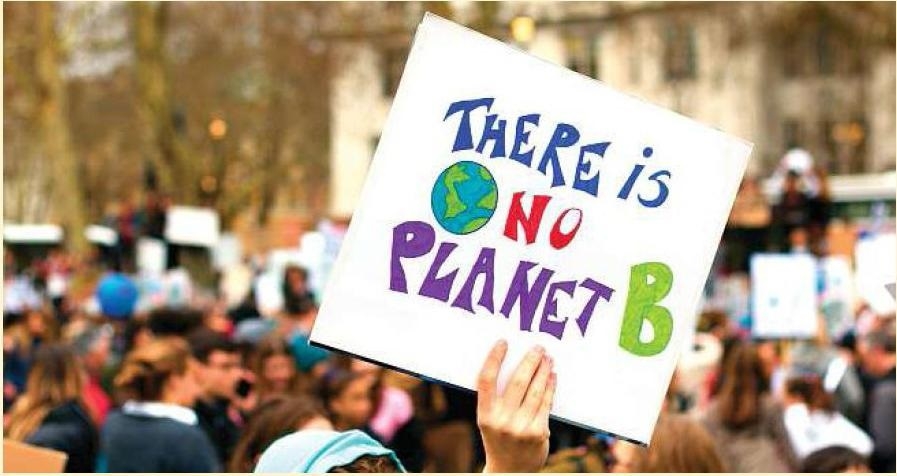COP in a bind
| Date :24-Sep-2022 |

By Kartik Lokhande :
A STHEworldis gearinguptoprepare for the 27th Conference of theParties totheUnitedNations Framework Convention on Climate Change (UNFCC), or COP27 in popularparlance,itwillbeopportunetotake a look at some of the issues that need aconsideration.For,thesearetheissues that may affect the processes through which the nations may achieve the goals or lag in fulfilling the commitments. In fact, since the COP26, a lot has changed in the world and new factors have comein.For instance,theRussiaUkraine war has impacted the world in general and Europe in particular. Coincidentally, winter shall set in around COP27 in Europe.

Thus, it will be time for Europe to witness increased energy demand to maintain warm thin house holds.However,giventheadverse impactofRussia-Ukrainewaronenergy security of the European countries, these countries may have to go back to coal and carbon-intensive power generation.Inthat case, meeting energy demand may be perceived by others as moving away from the famous European standards regarding emission. Another dilemma is concerning Africa. If Africa is to be encouraged to develop gas/energy sources to meet the energy demands of theWest orthe European countries, the developing countries may look at as endangeringtheecologyof the African countries. Already,thereareconcerns over cocoa harvesting, logging, and poaching activities disturbing the ecology in African countries. While a lot of attention is being paid to ‘African Voices’ these days in the Western media, financing Africa to develop gas to meet West’s energy demands may be treated as exploitation and media attention would be perceived as nothing butlip service.
Then, there are issues concerning climate financing.There are two types offinancing -- lossand damagefinancing and adaptation financing. As the namessuggest,lossanddamagefinancing iskindof compensatory,and adaptation financing focusses more on adaptation. As the recent floods suggest, PakistanintheneighbourhoodofIndia has failed on both the fronts. With its fragile economy, Pakistan has never been able to dedicate its financial resourcestoanyofthesetypesoffinancing. As a result, it has been left with a begging bowl seeking humanitarian assistancefromother countries to provide relief to people affected due to floods. The Russia-Ukraine war impeding global supplychainshasbadly impacted economies of the world, and this may affect climate financing from the donour countries. Some countries like Denmark have announced loss and damage financing to aid building climate-resilient infrastructure. Though various organisations and interest groups have started lobbying to enlist loss and damage financing as permanent item on the COP agenda, given the impact of COVID-19 pandemic and Russia-Ukraine war on global economies, therearevoices expressing concern if it is a good idea for the responsible economies tohelpthose neglecting environment and adaptationmeasures. Someare also raising question whether the religious fundamentalist countries deserve climate financing even after they have done little or nothing to pave way for clean energy pathways? Anotherissueintricatelylinkedtothe element of financing is whether such financing comes as a debt or grant. This is very interesting. As is the history, much of environmental and climate financing from developed economies came as a debt that had to be repaid by the recipient countries.
Corruption and lack of focus on outcome-based utilisation of finance affected many of the recipient countries. Apart from these countries not beingabletoachieve thesetgoals, they faced the crisis as they were not in a positiontorepaythe financethat came as debt. Especially the poor countries were left in a lurch. They needed climate or environmental financing in theform of grantbutgotdebt.Whether theCOP27givesathoughtothisaspect, also will be interesting to watch. Whileallthis ishappening,Indiahas been pretty focussed. Prime Minister Mr. Narendra Modi, during COP26 at Glasgow last year, mooted the gift of ‘Panchamrit’ on behalf of India.These five elements or points he proposed included -- raising India’s non-fossil fuel based energy capacity to 500 GW bytheyear2030,meetinghalfofIndia’s energy needs using renewable energy sources by 2030, reducing projectedcarbonemission by one billion tonnes by 2030, reducing carbon intensity of India’s economy by to below 45 per cent mark by 2030, and India becoming‘carbon neutral’ and achieving ‘net zero’ emissions by 2070. Alloftheseareverygood, but ambitious targets. If one considers the point of ‘net zero’ emissions alone, developing infrastructure in that direction may see a momentary growth in emissions for some time.
So, will it be okay or not, is a complex question. Given the disruption in global supply chain, ‘net zero’ may not be on horizon practically. For instance, if electric vehicles are to be a reality to reduce emissions from vehicles, how will a country like India powerthesevehicleswith non-coalsources of electricity? Further, effort towards achieving cleaner energy goals incorporates an element of automation for whichcomputerchipswillberequired. For these chips to be ready, raw materialwillhavetobesourcedthroughmining, which is considered an environmentally damaging activity. Against this backdrop, not only India but also other countries in the world are facing a complicated scenario while fulfilling the commitments. Overall,thesituationis complexand the COP27 will have to deal with it. However, forthebalancedapproachto emerge from the conference, the participating nations will have to sacrifice some self-interests and contribute to the global good. Of course, for that global good to be achieved, thinking will have to be oriented around smaller interventions that may positively affect the bulk instead of ambitious interventions trapped in heavy words. Simple things can help in decarbonisation or reducing carbon footprint. For example, going back to the old concept of buildings/apartments illuminated by natural light coming from windowsandopenspacesaroundmay reduce energy demand. At present, in the name of modern buildings, closed boxes are being constructed which require electricity-powered lighting. This electricity, presently, is generated throughcarbon-intensiveprocess.Also, inthenameof‘well-illuminated’spaces, the number of burning lamps has increased. Insteadofusingthetime-testedpractice of using an earthen pot to get cool water, refrigerators are being used in biggernumbersandthisleadstogreenhouse gas emissions. Urban planning fromthepointofviewofdecongestioncompliant roads also may help a lot, as traffic jams consumermore fueland increase emission levels. Of course, there maybemanymore simplethings thatneedtobeputinpracticetoachieve the larger goals. Against this backdrop, COP27 may be in a bind. For the difference to be made to life on Earth, time is running out fast and action needs to be taken in right earnest.